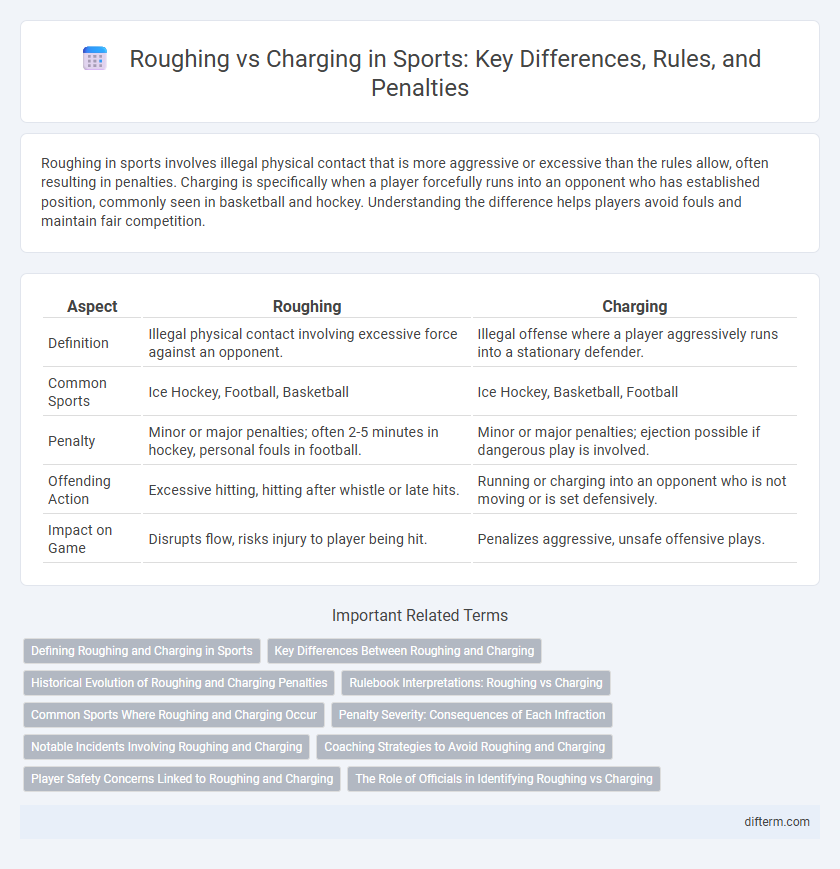Roughing in sports involves illegal physical contact that is more aggressive or excessive than the rules allow, often resulting in penalties. Charging is specifically when a player forcefully runs into an opponent who has established position, commonly seen in basketball and hockey. Understanding the difference helps players avoid fouls and maintain fair competition.
Table of Comparison
| Aspect | Roughing | Charging |
|---|---|---|
| Definition | Illegal physical contact involving excessive force against an opponent. | Illegal offense where a player aggressively runs into a stationary defender. |
| Common Sports | Ice Hockey, Football, Basketball | Ice Hockey, Basketball, Football |
| Penalty | Minor or major penalties; often 2-5 minutes in hockey, personal fouls in football. | Minor or major penalties; ejection possible if dangerous play is involved. |
| Offending Action | Excessive hitting, hitting after whistle or late hits. | Running or charging into an opponent who is not moving or is set defensively. |
| Impact on Game | Disrupts flow, risks injury to player being hit. | Penalizes aggressive, unsafe offensive plays. |
Defining Roughing and Charging in Sports
Roughing in sports refers to aggressive physical contact that exceeds the rules, such as unnecessary force or strikes that endanger player safety, commonly penalized to maintain fair play. Charging involves an offensive player aggressively colliding with a defender who has established position, typically resulting in a foul if the offensive player initiates excessive or illegal contact. Both fouls impact game dynamics and player discipline, differing primarily in the initiator and nature of the contact.
Key Differences Between Roughing and Charging
Roughing in sports involves illegal physical contact initiated to protect a player, often resulting in personal fouls and penalties. Charging occurs when an offensive player aggressively collides with a defender who has established position, typically leading to an offensive foul. Key differences include the initiator of contact and the intent behind the action, with roughing penalizing excessive force against players and charging penalizing aggressive offensive plays.
Historical Evolution of Roughing and Charging Penalties
Roughing and charging penalties in sports have evolved significantly since their inception, reflecting changes in player safety standards and game dynamics. Initially, roughing was broadly penalized to curb excessive physical aggression, while charging was introduced later to address illegal offensive maneuvers specifically during player contact. Over decades, rulebooks in hockey and football have refined these penalties with precise definitions and differentiated consequences, emphasizing fair play and reducing injury risks.
Rulebook Interpretations: Roughing vs Charging
Roughing and charging are distinct fouls in sports defined by rulebook interpretations, where roughing involves illegal physical contact against a player while charging is characterized by a player aggressively forcing contact against a defender. Rulebooks specify penalties for roughing to protect players from unnecessary force, whereas charging rules emphasize defensive positioning and player control. Clear differentiation ensures fair play and safety, with referees using specific criteria such as body position and intent to adjudicate each infraction accurately.
Common Sports Where Roughing and Charging Occur
Roughing and charging are common fouls in ice hockey and American football, where physical contact is a fundamental aspect of play. In ice hockey, roughing penalizes unnecessary or excessive physical aggression, while charging involves a player taking multiple strides to violently check an opponent. American football penalizes roughing the passer to protect quarterbacks, whereas charging is typically called illegal when a player forcefully collides into an opponent without proper engagement.
Penalty Severity: Consequences of Each Infraction
Roughing penalties often result in more severe consequences, including a 15-yard penalty and automatic first down due to the increased risk of player injury from unnecessary physical contact. Charging typically incurs a 5- or 10-yard penalty without automatic first down, as it involves illegal force while initiating contact with the opponent. The severity of roughing penalties reflects the sport's emphasis on player safety, whereas charging penalties focus more on maintaining fair play and controlled aggression.
Notable Incidents Involving Roughing and Charging
Notable incidents involving roughing and charging highlight key moments of controversy in sports such as football and hockey. In the NFL, the 2017 NFC Championship Game featured a controversial roughing the passer penalty that influenced the outcome, while the NHL's 2019 Stanley Cup playoffs included a high-profile charging penalty that led to a pivotal power play. These incidents emphasize the critical role of officiating in maintaining player safety and game fairness during intense physical confrontations.
Coaching Strategies to Avoid Roughing and Charging
Coaches emphasize proper positioning and anticipation techniques to minimize penalties for roughing and charging in sports. Drills that enhance players' spatial awareness and disciplined tackling help reduce aggressive infractions. Incorporating video analysis allows teams to identify risky behaviors and adjust strategies for cleaner, more controlled physical play.
Player Safety Concerns Linked to Roughing and Charging
Roughing in sports often involves excessive physical contact that increases the risk of concussions and other serious injuries, raising significant player safety concerns. Charging typically entails a player aggressively running into an opponent, which can lead to dangerous collisions and heightened injury potential. Both fouls are closely monitored to enforce rules that protect players and minimize the risk of long-term health consequences.
The Role of Officials in Identifying Roughing vs Charging
Officials play a critical role in distinguishing roughing from charging by closely monitoring player contact and intent during physical confrontations. They assess whether a player initiates unnecessary force beyond the rules, such as delivering a hit after the whistle (roughing), or aggressively driving into an opponent using the body as a battering ram (charging). Accurate judgment ensures fair play and player safety by enforcing penalties that reflect the severity and nature of each infraction in sports like hockey and basketball.
roughing vs charging Infographic

 difterm.com
difterm.com